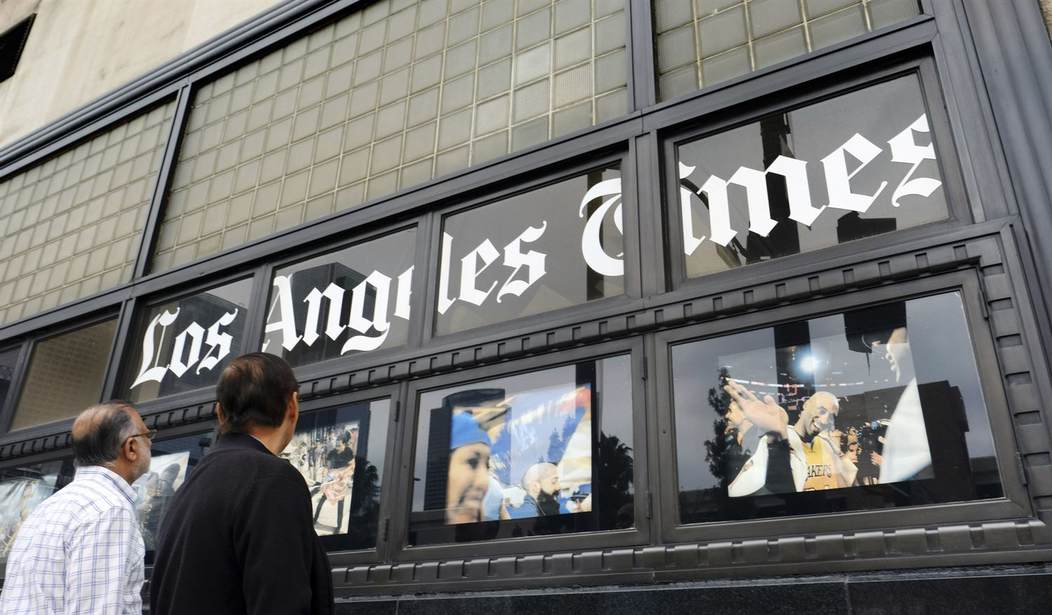We turn once again to what has long been and surely will continue to be a limitless source of material for my columns, which is the practice at the Los Angeles Times of trying to concoct a scandal from an entirely lawful and justifiable police shooting. The latest example of this appears in Thursday’s print edition, running under the headline, “Footage casts doubt on LAPD claims.” The sub-headline reads, “Police said Marvin Cua pointed a gun at officers. But video shows him fleeing.” The sensational headline and the story’s placement in the paper — above the fold on the front page — tells the reader that we here at the Times think this is a Very Important Story.
The story, available online here, follows the paper’s formulaic approach when reporting on such cases. First comes the headline hinting at something nefarious, then comes the reportage that elides details about the shooting and the victim’s criminal history, presents the victim as a good person who was at the very threshold of accomplishing great things, and finally includes the opinions of some academic whose title suggests expertise on the matter but whose actual experience says otherwise.
On June 2, at about 9 a.m., the LAPD received a 911 call reporting a man who was seen spray-painting gang graffiti and pointing a handgun at children in the 700 block of South Berendo Street, about two and a half miles west of downtown Los Angeles. Uniformed officers in a marked police car responded to the area and saw Marvin Cua, 23, walking with another man on the east side of Berendo. Body camera video shows the passenger officer exiting the police car and telling the men to stop. Cua does not comply and instead runs south on Berendo while holding a handgun. As Cua nears the parking lot of a strip mall at the corner of Berendo and 8th Street, the officer fires a single round, striking Cua. Cua continues running but soon collapses in the parking lot. Officers perform first aid, including CPR, but paramedics arrive to find he has died.
The Times attempts to create controversy by pointing out that, in the LAPD video presentation on the shooting from the department’s Media Relations Division, a police captain states that Cua “removed a handgun from his waistband [and] pointed it in the direction of the officers.”
“But,” says the Times, “the footage that follows does not show Cua doing that.”
Which is true, as far as it goes, but the captain did not claim the video showed Cua pointing the weapon. The captain’s assertion may have been derived from statements provided by the officers, other witnesses, or from sources not made clear in the presentation. As illuminating as body-worn cameras can be in many situations, their limitations are made manifest in the Cua shooting. Not everything an officer perceives is captured on his camera, and not everything that is captured on camera is perceived by the officer.
In the LAPD video, the officers can be seen going “code six,” i.e., at the scene and investigating a possible suspect from the radio call at the 4:46 mark. The shot is fired at 4:59. During the intervening thirteen seconds, Cua is at times out of frame as he runs, and at other times he is obscured from the camera’s view by a parked car or the officer’s arm, at any of which points he may indeed have pointed his gun at the officers.
And in any event, whether Cua pointed the gun at the officers or not is irrelevant in evaluating the justification for the shooting. Yes, had Cua been shown on video pointing the gun at the officers, it would have provided additional justification for the shooting, but the officer was justified in firing even if Cua hadn’t pointed it at them.
Cua was reported to have pointed the gun at children in the area, and when confronted by police he chose not to drop the weapon and surrender but rather to hold it and flee in a densely populated area. Given these facts, an officer must assume that a suspect who holds his weapon while fleeing will use it against him or someone else if given the opportunity, and the officer need not wait for this to happen before using deadly force.
The Times story also seeks to imply the shooting was unjustified because the officer fired “without warning.” But as the reporter should know, under these circumstances California makes no demand for a warning. California Penal Code section 835a(c)(1)(B) states that an officer may use deadly force “to apprehend a fleeing person for any felony that threatened or resulted in death or serious bodily injury, if the officer reasonably believes that the person will cause death or serious bodily injury to another unless immediately apprehended. Where feasible, a peace officer shall, prior to the use of force, make reasonable efforts to identify themselves as a peace officer and to warn that deadly force may be used, unless the officer has objectively reasonable grounds to believe the person is aware of those facts.” [emphasis added]
In the Cua shooting, the officers were in uniform and driving a marked car in daylight. There can be no doubt Cua knew that they were police officers and that he might be shot if he did not drop his gun and surrender. He made his choices, for which the police cannot be blamed.
Following the Times’s formula, we are of course presented with a sympathetic picture of the victim, this one supplied by Margaret Hellerstein, an immigration attorney who represented Cua in a request for asylum. “He was an incredibly gifted artist,” she said. “He was soft-spoken, he was generous, he was funny. I know he wasn’t a saint, but he had a huge heart. I genuinely loved him.”
The admission that Cua “wasn’t a saint” is of course an acknowledgment of his criminal history, about which the Times was insufficiently curious to report. What became of his asylum application, the legitimacy of his claim, and his current immigration status also go unexplored. And if Hellerstein had an opinion on why the soft-spoken, generous, funny, gifted artist may have invited the police response by pointing a gun at children that day, the reporter did not convey it.
No L.A. Times story on a police shooting would be complete without the opinion of some college professor questioning the officers’ actions, even if the professor’s expertise is not relevant to the issues under discussion. For this, the Times turned to William Terrill (whose name they misspell as “Terrell”). Terrill is a professor and associate dean at Arizona State University, whose C.V. reveals a good deal of academic research on police use of force but nothing to suggest any practical experience in the field, save for a mention of his having been a military police officer at some time.
As reported by the Times, Terrill “questioned whether the officers might have chosen a different approach that didn’t seemingly escalate the situation.”
“I don’t know if that’s their training tactic to drive up slowly with their door open to someone who’s reported to be armed,” Terrell said. “I did find that somewhat strange.”
No, professor, it’s not the least bit strange. The officers answered a report of an armed man, a description of whom proved to be accurate. They drove into the area looking for the suspect, saw him, and tried to detain him. How might they have responded differently other than to allow Cua to flee with his gun into a crowded area? If Professor Terrill offered a practical alternative, the story did not include it.
Like nearly everyone shot by the police, Marvin Cua arrived at his end through a series of bad decisions, none of which the officers had the power to change. Whatever his merits as an artist, regardless of how beloved he may have been to some, he brought about his own demise. The shooting was both reasonable and necessary, as California law demands, and nothing that appears in the Los Angeles Times will change that.









Join the conversation as a VIP Member